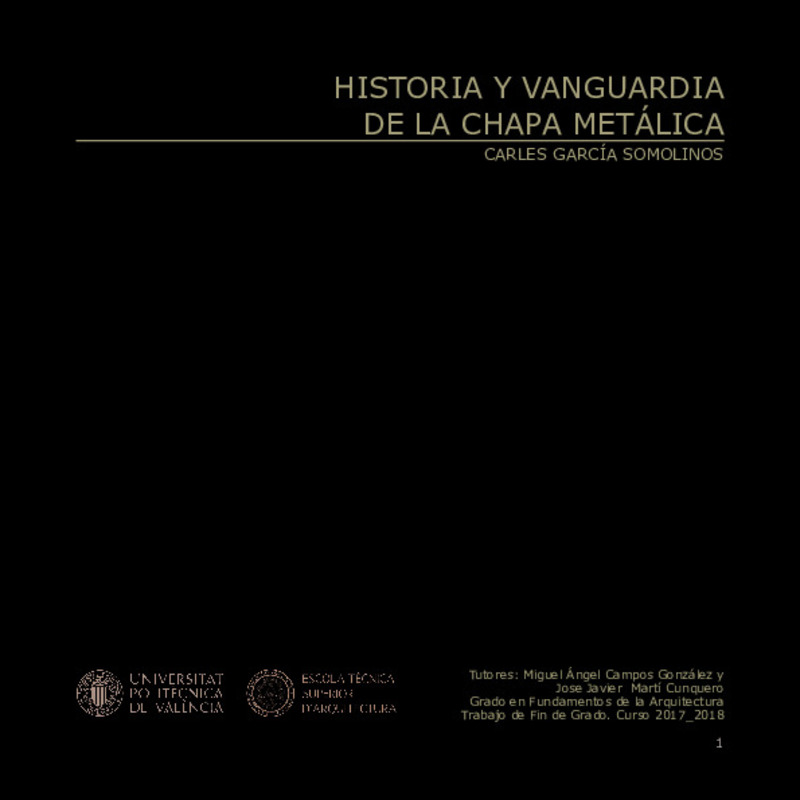JavaScript is disabled for your browser. Some features of this site may not work without it.
Buscar en RiuNet
Listar
Mi cuenta
Estadísticas
Ayuda RiuNet
Admin. UPV
Historia y vanguardia de la chapa metálica
Mostrar el registro sencillo del ítem
Ficheros en el ítem
| dc.contributor.advisor | Campos González, Miguel Ángel
|
es_ES |
| dc.contributor.advisor | Martí Cunquero, José Javier
|
es_ES |
| dc.contributor.author | García Somolinos, Carles
|
es_ES |
| dc.date.accessioned | 2019-02-08T14:17:28Z | |
| dc.date.available | 2019-02-08T14:17:28Z | |
| dc.date.created | 2018-09-13 | |
| dc.date.issued | 2019-02-08 | es_ES |
| dc.identifier.uri | http://hdl.handle.net/10251/116553 | |
| dc.description.abstract | [ES] El desarrollo de técnicas del conformado de la chapa metálica está abriendo infinidad de posibilidades en el campo de la arquitectura. Pero no se puede olvidar su evolución en la história de la humanidad, desde que Leonardo da Vinci hizo el primer borrador, y sus aplicaciones en la arquitectura, como la que realiza Hugo Junkers en sus hangares. Es importante analizar su recorrido hasta la actualidad para saber de donde proviene y de lo que es capaz. Posteriormente se realiza un estudio de los métodos de conformado mas novedosos, y de sus aplicaciones en la arquitectura. Lo que caracteriza a estas técnicas innovadoras es el uso de herramientas no convencionales como fluidos, gases o herramientas flexibles para poder conformar multitud de formas. Finalmente se hace una comparativa de tres proyectos, los dos primeros existentes y el tercero propio, para ver la evolución y las oportunidades que ofrece el material junto con las nuevas técnicas. Aunque la chapa carezca de estabilidad propia gracias al conformado, puede llegar a ser una alternativa barata, ligera y eficiente a algunos sistemas constructivos tradicionales, al igual que una hoja de papel puede ganar consistencia doblándose y deformándose. | es_ES |
| dc.description.abstract | [EN] Development of sheet metal forming techniques is opening up countless possibilities in the field of architecture. But we cannot forget its evolution in the history of humanity since Leonardo da Vinci drew his first sketch, and its applications in architecture, as Hugo Junkers, does in his hangars. It is important to analyze its journey to the present day to know where it comes from and what it is capable of. Subsequently, a study of the most innovative forming methods and their applications in architecture is carried out. What characterizes these innovative techniques is the use of non-conventional tools such as fluids, gases or flexible tools to shape a multitude of forms. Finally, a comparison is made of three projects, the first two existing and the third being a personal proposal, to see the evolution and opportunities offered by the material together with the new techniques. Although the sheet does not have stability, with the newly forming methods can become a cheap, light and efficient alternative to some traditional construction systems as a sheet of paper can gain consistency by folding and deforming it. | es_ES |
| dc.format.extent | 79 | es_ES |
| dc.language | Español | es_ES |
| dc.publisher | Universitat Politècnica de València | es_ES |
| dc.rights | Reconocimiento - No comercial - Sin obra derivada (by-nc-nd) | es_ES |
| dc.subject | Chapas metálicas | es_ES |
| dc.subject | Conformado | es_ES |
| dc.subject | Estructuras | es_ES |
| dc.subject | Revestimientos | es_ES |
| dc.subject | Metal sheets | es_ES |
| dc.subject | Forming process | es_ES |
| dc.subject | Structures | es_ES |
| dc.subject | Coatings | es_ES |
| dc.subject | Museo Guggenheim Bilbao | es_ES |
| dc.subject | Dongdaemun Design Plaza | es_ES |
| dc.subject.classification | PROYECTOS ARQUITECTONICOS | es_ES |
| dc.subject.other | Grado en Fundamentos de la Arquitectura-Grau en Fonaments de l'Arquitectura | es_ES |
| dc.title | Historia y vanguardia de la chapa metálica | es_ES |
| dc.type | Proyecto/Trabajo fin de carrera/grado | es_ES |
| dc.rights.accessRights | Abierto | es_ES |
| dc.description.bibliographicCitation | García Somolinos, C. (2018). Historia y vanguardia de la chapa metálica. http://hdl.handle.net/10251/116553 | es_ES |
| dc.description.accrualMethod | TFGM | es_ES |
| dc.relation.pasarela | TFGM\88901 | es_ES |
Este ítem aparece en la(s) siguiente(s) colección(ones)
-
ETSA - Trabajos académicos [4687]
Escuela Técnica Superior de Arquitectura






